How Do I Inspect Synthetic Rope Slings to ASME B30.9 Standards?
Synthetic rope slings are preferred in certain lifting applications in the construction, shipyard, and offshore and deepwater industries. However, synthetic rope slings can be more prone to damage from heat, chemicals, and abrasion or cutting when lifting loads with sharp corners or edges. So, regular inspection is key when forming synthetic rope into slings for lifting applications.
Synthetic rope slings are increasing in popularity—especially as synthetic rope becomes more widely accepted and specified for different lifting applications. Synthetic rope slings come in a variety of braided constructions that are extremely strong, durable, lightweight, and flexible.
With synthetic rope slings, you get a product with the strength and durability of wire rope and chain slings, plus the weight-savings and load protection of synthetic slings—all in one product.
Synthetic rope slings are preferred in certain lifting applications in the construction, shipyard, and offshore and deepwater industries. However, synthetic rope slings can be more prone to damage from heat, chemicals, and abrasion or cutting when lifting loads with sharp corners or edges. So, regular inspection of synthetic rope slings is key when using them for lifting applications.
There’s a chapter in the ASME B30.9 Slings standard dedicated to the selection, use, inspection, and maintenance of synthetic rope slings. If you’re unfamiliar with this standard, or new to the use of synthetic rope slings, we’ll walk you through the following in this article:
- How often you need to inspect synthetic rope slings
- Synthetic rope sling construction and component specifications
- What information is required for sling identification
- Inspection criteria for synthetic rope slings
- Best practices for maintaining synthetic rope slings
How Often Do You Need to Inspect Synthetic Rope Slings?
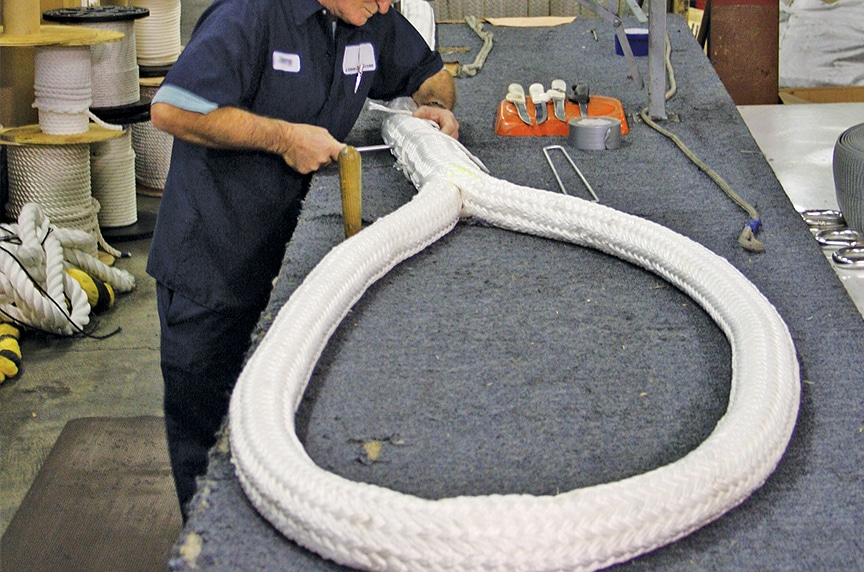
All inspections shall be performed by a Designated Person with any deficiencies further examined by a Qualified Person to identify hazards and determine what additional steps need to be taken to address the hazard.
There are two industry standards that exist to provide the end-user with guidelines for inspection and criteria that warrants removal from service: OSHA 1910.184 and ASME B30.9.
Initial Inspection (Prior to Initial Use)
Best practice is to inspect any synthetic rope sling upon receiving it from the manufacturer. Double-check the sling identification to make sure it’s what you ordered and that the rated capacity meets all of your project specifications and lifting requirements.
Frequent Inspection (Daily or Prior to Use)
Designate a Competent Person to perform a daily visual inspection of slings and all fastenings and attachments for damage, defects, or deformities. The inspector should also make sure that the synthetic sling that was selected meets the specific job requirements it’s being used for.
However, users can’t rely on a once-a-day inspection if the sling is used multiple times throughout the day. Shock loads, severe angles, edges, and excessive heat can quickly cause damage to the material, so best practice is to perform a visual inspection prior to each use.
Periodic Inspection
A documented periodic inspection is performed by either a professional inspection provider, or by a Qualified Person, every 12 months (at a minimum) and monthly to quarterly in more severe service conditions. The following are all determining factors in scheduling the frequency of a periodic inspection of synthetic rope slings:
- Frequency of use
- Severity of service conditions
- Nature of the lifts being performed
- Experience gained on the service life of synthetic rope slings used in similar applications
ASME provides these additional periodic rope sling inspection guidelines based on the service of the sling:
- Normal Service – Yearly
- Severe Service – Monthly to Quarterly
- Special Service – As recommended by a Qualified Person
Depending on the severity of the operating environment and frequency of use, your business may decide that a thorough synthetic rope sling inspection should occur more often than the minimum yearly requirement.
Periodic inspections are required to be documented per ASME B30.9 and records retained. The employer is required to maintain a record of the most recent thorough inspection, however inspection records of individual slings are not required.
Failure to maintain and retain inspection records is one of the most common issues we see that can prevent a company from reaching full OSHA compliance.
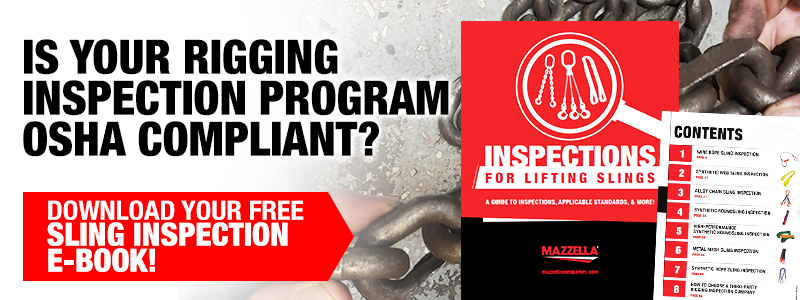
Synthetic Rope Sling Construction and Component Specifications
ASME B30.9 has laid out specifications for the construction and components of synthetic rope slings.
Synthetic Ropes
Although ASME B30.9 covers synthetic ropes made from either nylon or polyester fiber materials, fiber rope slings can also be made from a variety of other synthetic fiber materials. These ropes shall be made of fibers that have been produced with an appropriate ultraviolet inhibitor.
Rope constructions covered under ASME B30.9 include three-strand laid, eight-strand plaited, single braided, and double braided. ASME requires that each rope construction be manufactured and tested in accordance with the following Cordage Institute specifications:
| Rope Type | Designation |
| Nylon Three-Strand Laid | CI 1303 |
| Nylon Eight-Strand Plaited | CI 1303 |
| Nylon Double Braid | CI 1306 |
| Polyester Three-Strand Laid | CI 1304 |
| Polyester Eight-Strand Plaited | CI 1304 |
| Polyester Double Braid | CI 1307 |
| Polyester Single Braid | CI 1305 |
Fittings
Fittings should be selected to meet the following requirements:
- Suitability of mechanical or socketed fittings shall be verified by a qualified person
- Material shall be compatible with the mechanical and environmental requirements imposed on the sling
- Fittings shall have sufficient strength to sustain twice the rated load of the sling without visible permanent deformation
- Fitting surfaces in contact with the sling shall be finished to remove edges that could damage the sling
- Thimbles shall have a minimum diameter at the beating surface of at least 2 times the rope diameter
- When employed, hooks shall meet the requirements of ASME B30.10
- When employed, rigging hardware shall meet the requirements of ASME B30.26
Other Components
Slings that employ synthetic ropes and fittings other than those listed in ASME B30.9 may be used. When such components are employed, the sling manufacturer or a Qualified Person shall provide specific data regarding deviations from the applicable sections of the B30.9 standard and shall comply with all other requirements of the B30.9 standard.
What’s Required for Synthetic Rope Sling Identification?
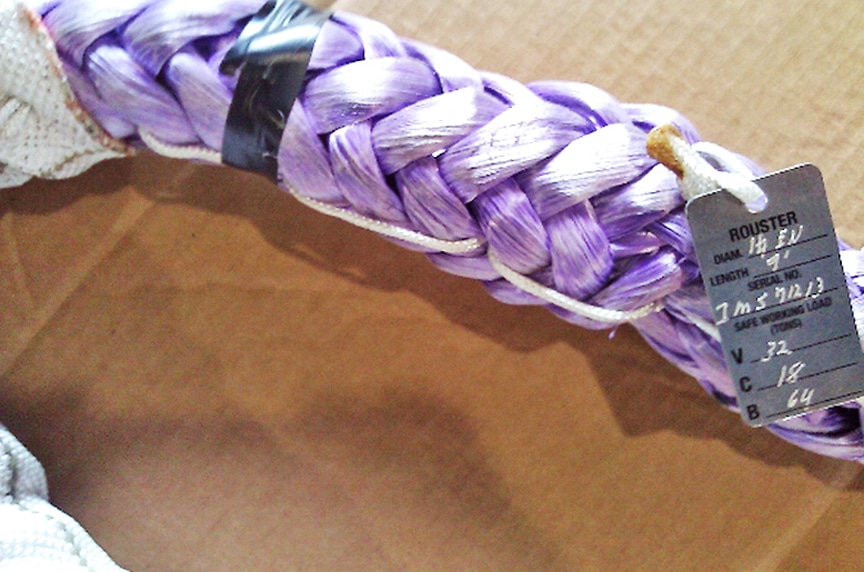
Per ASME B30.9, each synthetic rope sling shall be marked by the manufacturer to include:
- Name or trademark of the manufacturer, or if repaired, the entity performing the repair
- Manufacturer’s code or stock number
- Rated load for at least one hitch type and the angle upon which it is based
- Type of fiber material
- Number of legs, if more than one
It is the responsibility of the user to maintain the sling identification—ensuring it remains legible during the life of the sling. If the identification is missing or illegible, it should be removed from service.
ASME B30.9 Inspection Criteria for Synthetic Rope Slings
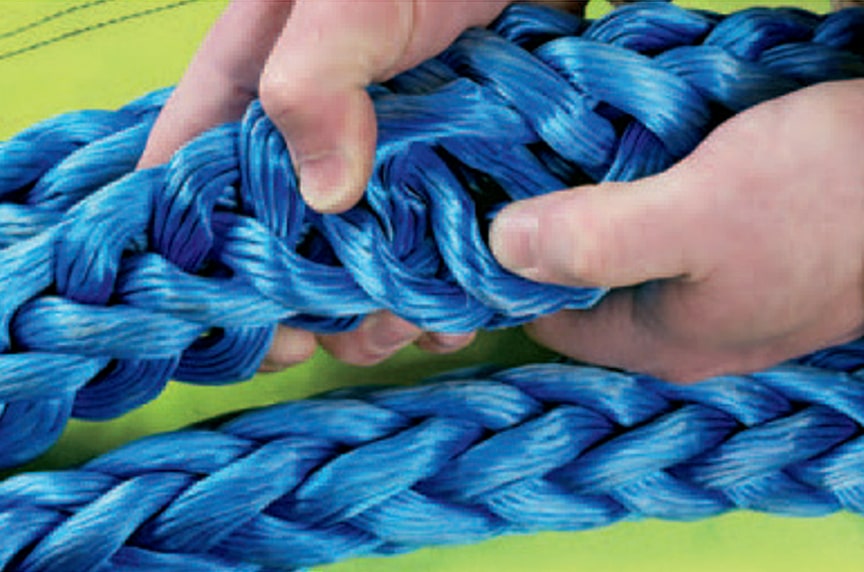
The goal of a sling inspection is to evaluate remaining strength in a sling which has been used previously to determine if it is suitable for continued use. When inspecting synthetic rope slings, daily visual inspections are intended to detect serious damage or deterioration which would weaken the strength and integrity of the sling.
If during any point of the inspection the following is observed, a synthetic rope sling should be removed from service, according to ASME B30.9 standards:
- Missing or illegible sling identification
- Cuts, gouges, areas of extensive fiber breakage along the length, and abraded areas on the rope
- Damage that is estimated to have reduced the effective diameter of the rope by more than 10%
- Uniform fiber breakage along the major part of the length of the rope in the sling such that the entire rope appears covered with fuzz or whiskers
- Inside the rope, fiber breakage, fused or melted fiber (observed by prying or twisting to open the strands) involving damage estimated at 10% of the fiber in any strand or the rope as a whole
- Discoloration, brittle fibers, and hard or stiff areas that may indicate chemical damage, ultraviolet damage, or heat damage
- Dirt and grit in the interior of the rope structure that is deemed excessive
- Foreign matter that has permeated the rope and makes it difficult to handle and may attract and hold grit
- Kinks or distortion in the rope structure, particularly if caused by forcibly pulling on loops (known as hockles)
- Melted, hard, or charred areas that affect more than 10% of the diameter of the rope or affect several adjacent strands along the length that affect more than 10% of strand diameters
- Poor condition of thimbles or other components manifested by corrosion, cracks, distortion, sharp edges, or localized wear
- For hooks, removal criteria as stated in ASME B30.10
- For rigging hardware, removal criteria as stated in ASME B30.26
- Other conditions including visible damage that cause doubt as to the continued use of the sling
Best Practices for Maintaining Synthetic Rope Slings
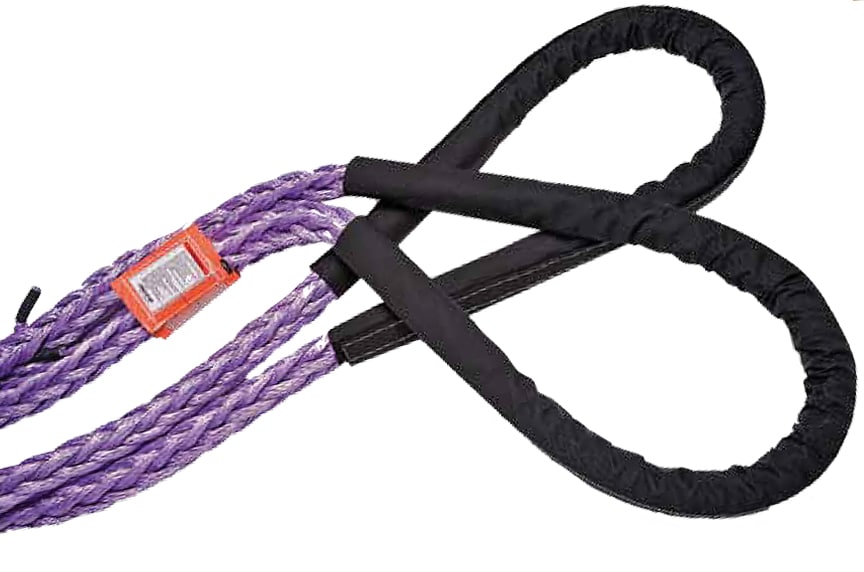
Maintaining a synthetic rope sling during and in between uses is the best way to help extend the life of it and help to ensure that it stays in service. Inspections are easier to perform—and probably more thorough—when slings are easily accessible and organized, kept off of the ground, and stored in a cool and dry environment.
Hang up your slings or keep them in a designated locker or rigging box where they are off of the ground and will not be subjected to mechanical damage, corrosion, chemical or ultraviolet exposure, or extreme temperatures.
Temperature
Polyester and nylon rope slings shall not be used in contact with objects or at temperatures above 194°F (90°C) or below –40°F (–40°C).
Chemically Active Environments
The strength of synthetic rope slings may be degraded by chemically active environments. This includes exposure to chemicals in the form of solids, liquids, gases, vapors, or fumes. The sling manufacturer or a qualified person should be consulted before slings are used in chemically active environments.
When slings or their fittings are to be exposed to acidic or alkaline fumes, vapors, sprays, mists, or liquids, the sling manufacturer or a qualified person should be consulted.
Polyester and nylon materials have different chemical resistance properties. Please refer to the chart below for guidelines on polyester or nylon material in specific chemically-active environments:
| Nylon | Polyester | |
| Acids | No | * |
| Alcohols | Yes | Yes |
| Aldehydes | Yes | No |
| Strong Alkalis | Yes | ** |
| Bleach Agents | No | Yes |
| Dry Cleaning Solvents | Yes | Yes |
| Ethers | Yes | No |
| Halogenated Hydrocarbons | Yes | Yes |
| Hydrocarbons | Yes | Yes |
| Ketonnes | Yes | Yes |
| Oils (Crude) | Yes | Yes |
| Oils (Lubricating) | Yes | Yes |
| Soaps & Detergents | Yes | Yes |
| Water & Sea Water | Yes | Yes |
| Weak Alkalis | Yes | Yes |
* Disintegrated by concentrated sulfuric acid
** Degraded by strong alkalis at elevated temperatures
Sunlight and Ultraviolet Light
The strength of synthetic rope slings is degraded by exposure to sunlight or ultraviolet light. The sling manufacturer or a qualified person should be consulted for additional retirement or inspection requirements.
Edge and Cut Protection
Slings in contact with edges, corners, or protrusions, should be protected with a material of sufficient strength, thickness, and construction to prevent damage.
Edge protection and cut protection should be used on all edges and corners—even the ones that aren’t load-bearing surfaces.
Keep Your Slings Clean
Continual exposure to dust, dirt, and moisture can degrade the materials and cause corrosion—shortening the life expectancy of the product. Wipe grease or oil off of your slings and try to keep them clean of dirt, grit, chemicals, or other particulates which can break down the material over time.
Slings exposed to salt water should be thoroughly rinsed with fresh water to prevent mechanical damage from salt crystals when the rope dries.
Avoid Misuse and Abuse
Use rigging best practices when lifting a load with synthetic rope slings. Avoid the following before, during, and after an overhead lift to prevent damage to the sling:
- Avoid shock loading
- Slings shall not be shortened or lengthened by knotting or twisting
- Loads should not be rested on the sling
- Slings should not be pulled from under a load if a load is resting on a sling
- Avoid twisting and kinking
- Do not drag the slings across the floor or over an abrasive surface
- Slings should not be constricted, bunched, or pinched by the load, hook, or any other fitting
Wrapping it Up
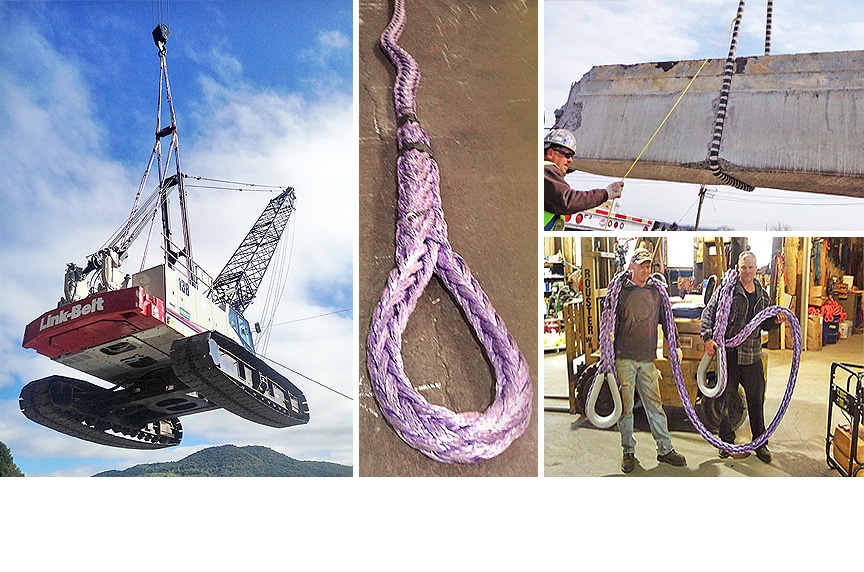
A well thought-out sling inspection program can help prevent industry compliance issues, keep your workers safe, and extend the life of your lifting equipment.
At Mazzella, we understand the amount of effort and coordination it can take to stay in compliance with OSHA and ASME’s industry standards. We offer a variety of services including site assessments, rigging and crane operator training, sling inspection and repairs, overhead crane inspections and so much more.
Our Rigging Inspection Services group is its own dedicated business unit with a team of inspectors that are certified through Industrial Training International to meet OSHA 1910.184 and ASME B30.9 requirements for sling inspection.
If you want more information on our sling inspection program or want to schedule a consultation to learn how you can assess the compliance of your lifting and rigging program, contact a Lifting Specialist today.
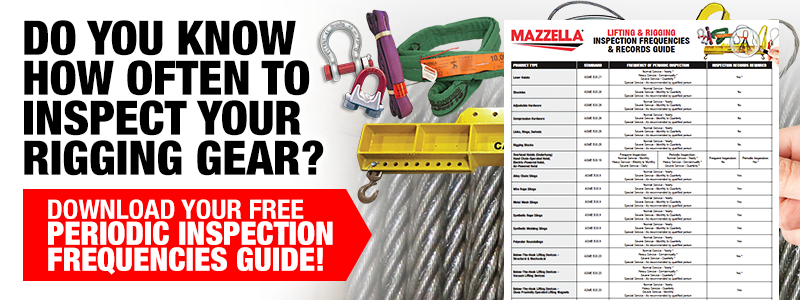

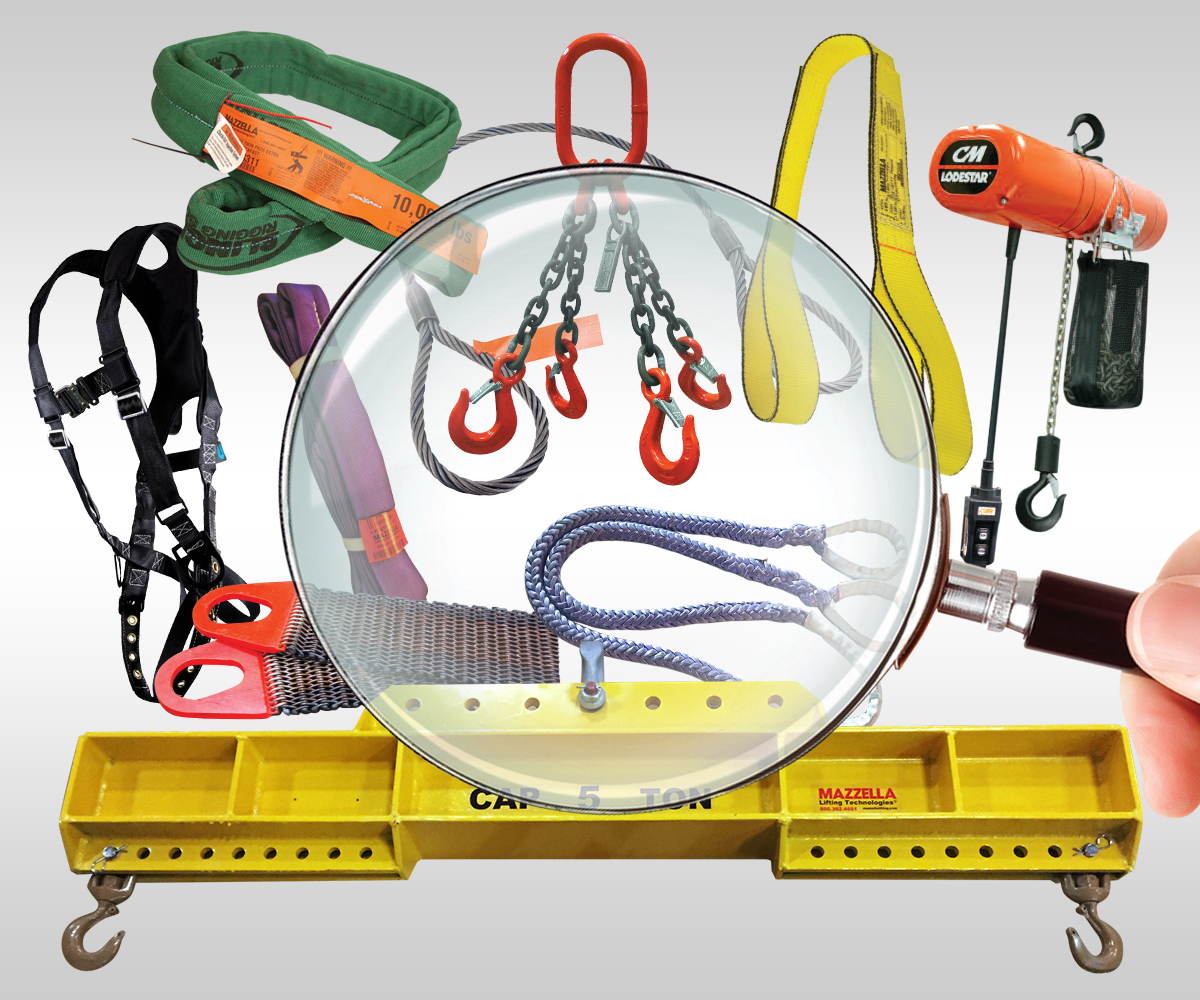
Rigging Inspection Services
OSHA 1910.184, ASME B30.9, B30.20, B30.26, & ANSI Z359 require periodic, documented inspections on slings, rigging hardware, lifting devices, and fall protection every 12 months, at minimum, and monthly to quarterly in more severe service conditions.
Call us at 800.362.4601 or click here if you need inspections for slings, rigging hardware, lifting devices, or fall protection!
Copyright 2019. Mazzella Companies.
